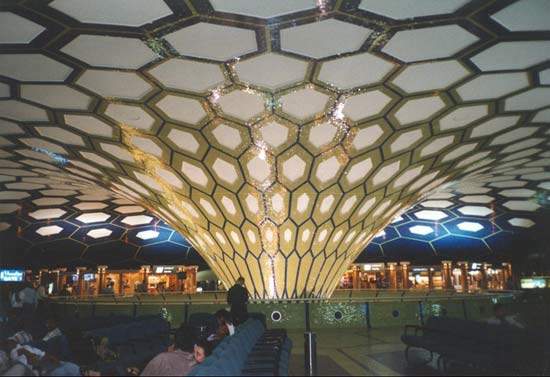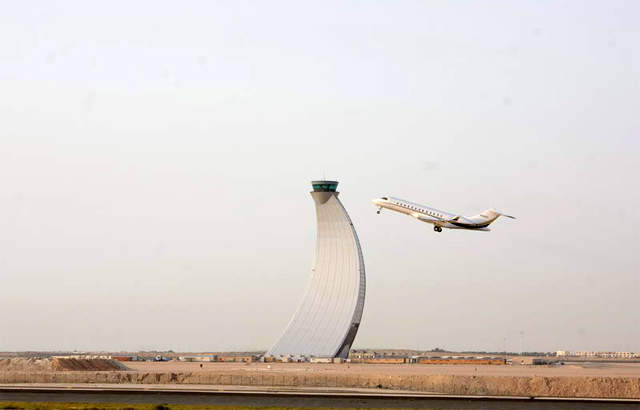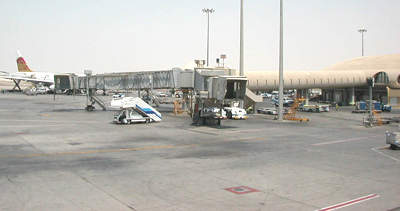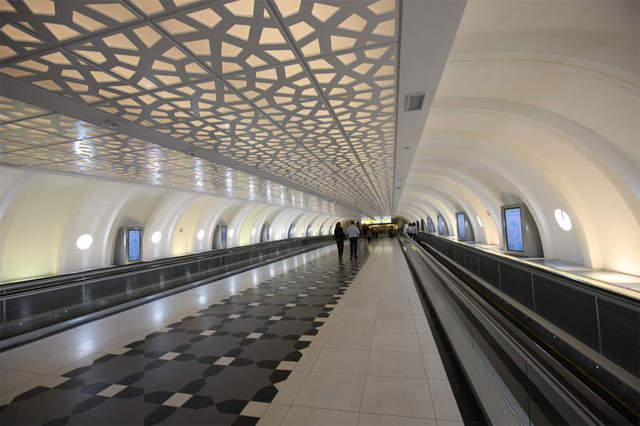Abu Dhabi International Airport, which is located in the emirate of Abu Dhabi, UAE, completed expansion projects in 2002. These involved a new 4,100m runway and taxiway, a new satellite terminal, a rapid transit shuttle and a series of 18 new aircraft stands that cost nearly $230m; however, the resulting increase in passenger traffic proved to be more than the airport could handle comfortably.
In 2004, the Abu Dhabi Department of Civil Aviation, in conjunction with the Supervision Committee for the Expansion of Abu Dhabi International Airport (SCADIA), began work on a more ambitious expansion plan to transform Abu Dhabi International Airport into a major transport hub for the Middle East for both cargo and passengers.
In August 2006, all of the country’s airports were privatised and placed under the auspices of the Abu Dhabi Airports Company (ADAC) – with a share value of AED500m. ADAC now oversees all work relating to Abu Dhabi International Airport’s midfield terminal development and the further expansion of its facilities.
In December 2006, Singapore’s Changi Airport was awarded a management and operations contract for Abu Dhabi International Airport. In January 2007, Changi was also retained as a consultant to advise ADAC on its ongoing expansion plan at the airport. Changi Airport is the operations and consulting subsidiary of the Civil Aviation Authority of Singapore.
Abu Dhabi International Airport traffic
The airport was used by over 3.4 million passengers in 1998. By 2004, this had increased to 5.2 million, then to 5.4 million in 2005 and 6.7 million in 2006. Abu Dhabi Airport was used by 11 million passengers in 2010, a 12% on 2009’s figure.
Cargo volumes also showed a strong increase in 2010 with 438,000t, a rise of 16%. Aircraft movements for the same year increased by 10% to 112,000 from 2009.
The number of airlines using the airport has also risen, as have the number of flights and range of international destinations. The authorities responsible for the airport recognised this growth and put two plans into action to increase its capacity.
Abu Dhabi Airport expansion plans
The first phase of the expansion project (AED300m) included the construction of two new terminal buildings with a capacity of three million passengers a year. These were completed within six months of being designed and opened in September 2005 (built as a quick fix to the capacity problems at the airport). The terminals are designated Terminal 1A (8,000m2 with a capacity one million passengers a year) and Terminal 2 (12,000m2 with a capacity of two million passengers a year). The first phase also included nine aircraft hard standings.
Phase II of the expansion, which began in late 2006, includes the construction of a new super-sized midfield terminal building, along with a second parallel 4,100m runway, a new aircraft control tower and new cargo facilities (with a handling capacity of two million tonnes a year). The phase I of the new cargo terminal opened in September 2011. The 6,000m2 facility handles perishable goods.
This massive development is expected to cost $6.8bn and will take place to the north of the existing airport.
Additional plans have also been made for a 12km circular rail transport system with 19 stops, linking the city of Abu Dhabi with the airport and also the free trade zones as part of the airport expansion.
Midfield terminal
The development is essentially a new airport. When the new facilities are complete the existing airport will be phased out. The new mega midfield terminal complex will be capable of handling 27-30 million passengers a year initially and then later, as Abu Dhabi develops as a major Middle East transport hub, up to 50 million passengers a year (this should provide major competition to Dubai International airport).
The 6.7 million square feet terminal will initially include 39 gates, rising up to 49 gates in future.
The project will provide a top-quality home base for the United Arab Emirates national carrier Etihad Airways.
Abu Dhabi Airport terminals 1 and 1A
The new terminal 1A has been dedicated to Gulf Traveller, which flies to 45 destinations from Abu Dhabi, with its fleet of twin-engine, Boeing 767-300 short to medium-range narrow-bodied aircraft.
Terminal 1 was refurbished in November 2011, with extra check-in and immigration counters, and has expanded retail and food and beverages sections. The terminal has 54 check-in counters (from nine), fast and efficient baggage processing systems, dedicated 34 immigration and passport control booths, two departure gates and a spacious departure lounge.
A further $27.2m was committed to the construction of nine new Code E/F aircraft hard stands (with 400MHz power supplies), including two stands to handle the new, next-generation Airbus A380 double-decker airliner.
Other key aspects of the project included the design of remote aircraft stands complete with airfield ground lighting and hydrant fuel.
A new state-of-the-art concourse expansion in the original airport terminal for the exclusive use of Etihad Airways was also completed.
Abu Dhabi Airport terminal 2
The new 12,000m2 terminal 2, which opened in September 2005, now services 12 airlines. The terminal, although a relatively temporary measure, cost $30m to build (along with terminal 1A) and has a baggage handling system with an in-line security screening facility, flight information display system (FIDS), security surveillance and access control, 1,000m2 of duty free shopping and cafeterias, a business class lounge, an e-gate and an iris scan.
In addition, terminal 2 has a dedicated first and business class lounge, 18 check-in counters and 20 arrival and eight departure passport booths; the facility was designed to maximise passenger comfort and flow during both arrival and departure.
Abu Dhabi Airport terminal 3
Terminal 3 opened in January 2009 and boasts ten gates, two of which are capable of handling wide-bodied aircraft such as the A380. The terminal will accommodate the airline’s expected growth until the new mega midfield terminal is opened. Built at a cost of AED1bn, the terminal 3 building is spread across an area of 75,000m2 and has a passenger capacity of five million. It also features 20 premium check-in counters, duty free shops, restaurants and cafés.
The soft-launch of the CAT III (B) second runway introduced in October of 2008 will act as an interim facilities provider for the midfield terminal complex and would accommodate 12 million passengers per year. This terminal will be mainly used by Etihad Airways.
A business and logistics park has been proposed to attract companies wanting to set up base in the UAE. The park will have 19 boutiques and duty-free outlets. It will occupy a 12km2 site near the airport and is being constructed in two phases. Construction of the first phase started in 2007 and is expected to be completed in 2010. The second phase started in 2011 and will be completed in 2015.
Air traffic control
Completed in 2010, the new Air Traffic Control Complex (ATCC) at Abu Dhabi International Airport is a 109m high building equipped with advanced technologies. It is located in front of the new Midfield Terminal and between the two parallel runways and provides an optimum view to all the aprons and manoeuvring areas of the airport.
The ATCC building was built at a cost of AED 430m in 629 days, 24×7, involving 1,200 workers at the peak time of construction.
Environmental concerns
SCADIA has performed an environmental impact assessment at the proposed site for the new midfield mega terminal, and has begun the translocation of a spiny lizard, indigenous to this region, to a new habitat.
Excavation has also begun on three possible pre-Islamic archaeological sites, while work is also underway on the transplanting of a forest to the new northern boundary of the site for noise and visual screening.
An airport inside an airport
Abu Dhabi International Airport’s new 4,100m parallel runway and taxiway will cater to latest generation aircraft such as the Airbus A380. Cargo, free trade zones, catering, maintenance facilities and other commercial developments will be constructed between the two runways.
The new runway, which was designed by Halcrow, includes a large terminal building, a new 110m air traffic control (ATC) tower, a cargo and logistics centre, and a commercial area with a free zone and associated retail development. Abu Dhabi International Airport awarded Thales a contract for building a new 20-storey air traffic control complex (ATCC), situated between the existing and the new second runway. Aviation Navigation Services operation was launched at the new ATC in April 2011.
It is planned in two phases with the first phase having a capacity to handle 20 million passengers per year.
The architect behind the midfield terminal complex’s master plan, Kohn Pederson Fox, revealed that it will have an ‘X’ design. The KPF team adopted structural solutions that created a large, column-free zone that will allow for future space planning needs. The X-shaped plan involves a large ticketing hall framed by a series of long-span steel arches supporting the roof.
On completion, the hall will lead into a central area with a garden, a reference to Abu Dhabi’s reputation as the ‘Garden of the Gulf’.
Other contractors for the project include Besix Group (general construction), Al Jaber Energy Services and GHD.












